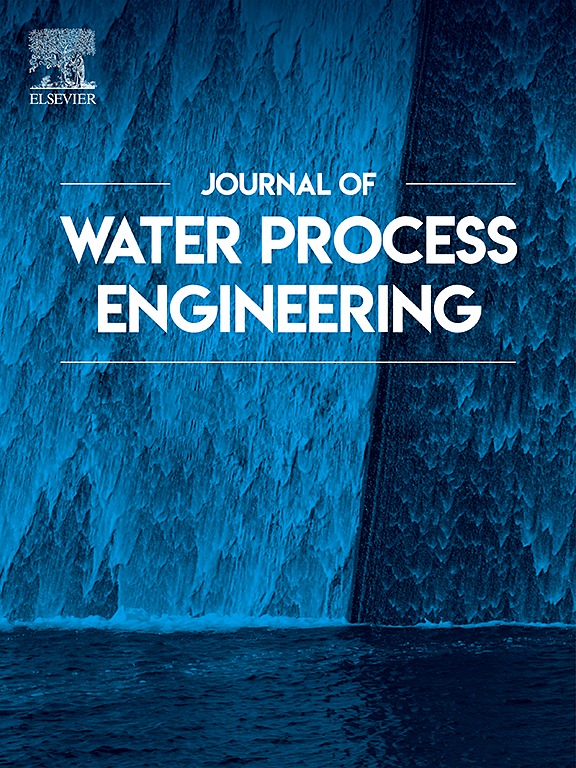Formation of Sb2S3 photocatalyst during antimony removal from mine drainage by Shewanella sp. ANA-3
IF 6.3
2区 工程技术
Q1 ENGINEERING, CHEMICAL
引用次数: 0
Abstract
Antimony (Sb) is not only a priority pollutant but also a critical mineral; therefore, strategies to simultaneously remove and recover Sb from wastewater are urgently needed. This study proposes a user-friendly biological treatment for managing Sb mine drainage using Shewanella sp. ANA-3 as the functional bacterium. When inoculated into Sb mine drainage supplemented with carbon and sulfur source, ANA-3 removed 85 % Sb within 96 h at the rate of 0.0158 mg·L−1·h−1. The removal mechanism was attributed to the formation of amorphous Sb2S3 precipitates, as confirmed by X-ray powder diffraction and Raman spectroscopy. Transmission electron microscope (TEM) revealed that Sb2S3 nucleation and growth initially occurred within the ANA-3 cells, with secretion taking place once particle size reached approximately 100 nm. High-resolution TEM further identified the precipitates as Sb2S3 nanospheres with an average diameter of 136 nm. These nanospheres exhibited an optical band gap of ~2.13 eV and a strong photochemical response under visible light, suggesting their potential for photocatalytic applications. Their photocatalytic activity was evaluated through the degradation of methyl orange dye, achieving an 85 % degradation rate with a rate constant of 0.011 min−1. This performance significantly surpassed that of commercial and chemically synthesized Sb2S3. The superior photocatalytic efficiency of the bio-formed Sb2S3 highlights its potential for broader applications. By combining efficient Sb removal and functional photocatalyst recovery, our study opens a new avenue for sustainable Sb remediation and recovery from Sb mine drainage.
希瓦氏菌ANA-3脱锑过程中Sb2S3光催化剂的形成
锑不仅是我国的重点污染物,而且是重要矿物;因此,迫切需要从废水中同时去除和回收锑的策略。本研究提出了一种以希瓦氏菌(Shewanella sp. ANA-3)为功能菌的友好型生物处理Sb矿山废水的方法。将ANA-3接种到添加碳硫源的Sb矿水中,96 h内以0.0158 mg·L−1·h−1的速率去除了85%的Sb。通过x射线粉末衍射和拉曼光谱分析证实,该去除机制归因于Sb2S3非晶析出物的形成。透射电镜(TEM)显示,Sb2S3最初在ANA-3细胞内成核和生长,当粒径达到约100 nm时开始分泌。高分辨率透射电镜进一步鉴定析出相为Sb2S3纳米球,平均直径为136 nm。这些纳米球的光学带隙为~2.13 eV,在可见光下具有较强的光化学响应,具有潜在的光催化应用前景。通过对甲基橙染料的降解评价了它们的光催化活性,降解率为85%,速率常数为0.011 min−1。这一性能大大超过了商业和化学合成的Sb2S3。生物形成的Sb2S3具有优异的光催化效率,具有广阔的应用前景。本研究将高效除Sb与功能光催化回收相结合,为Sb矿山废水中Sb的可持续修复和回收开辟了一条新的途径。
本文章由计算机程序翻译,如有差异,请以英文原文为准。
求助全文
约1分钟内获得全文
求助全文
来源期刊

Journal of water process engineering
Biochemistry, Genetics and Molecular Biology-Biotechnology
CiteScore
10.70
自引率
8.60%
发文量
846
审稿时长
24 days
期刊介绍:
The Journal of Water Process Engineering aims to publish refereed, high-quality research papers with significant novelty and impact in all areas of the engineering of water and wastewater processing . Papers on advanced and novel treatment processes and technologies are particularly welcome. The Journal considers papers in areas such as nanotechnology and biotechnology applications in water, novel oxidation and separation processes, membrane processes (except those for desalination) , catalytic processes for the removal of water contaminants, sustainable processes, water reuse and recycling, water use and wastewater minimization, integrated/hybrid technology, process modeling of water treatment and novel treatment processes. Submissions on the subject of adsorbents, including standard measurements of adsorption kinetics and equilibrium will only be considered if there is a genuine case for novelty and contribution, for example highly novel, sustainable adsorbents and their use: papers on activated carbon-type materials derived from natural matter, or surfactant-modified clays and related minerals, would not fulfil this criterion. The Journal particularly welcomes contributions involving environmentally, economically and socially sustainable technology for water treatment, including those which are energy-efficient, with minimal or no chemical consumption, and capable of water recycling and reuse that minimizes the direct disposal of wastewater to the aquatic environment. Papers that describe novel ideas for solving issues related to water quality and availability are also welcome, as are those that show the transfer of techniques from other disciplines. The Journal will consider papers dealing with processes for various water matrices including drinking water (except desalination), domestic, urban and industrial wastewaters, in addition to their residues. It is expected that the journal will be of particular relevance to chemical and process engineers working in the field. The Journal welcomes Full Text papers, Short Communications, State-of-the-Art Reviews and Letters to Editors and Case Studies
 求助内容:
求助内容: 应助结果提醒方式:
应助结果提醒方式:


